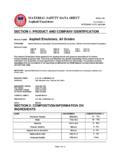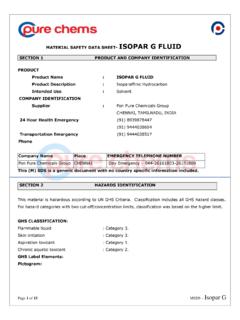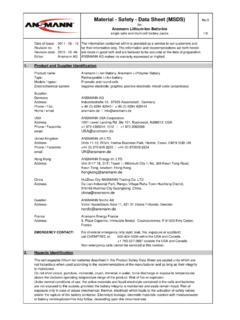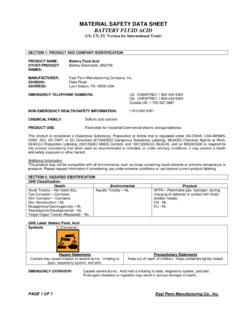Transcription of Material Safety Data Sheet MSDS Number: M1003 …
1 Material Safety data SheetTolueneMSDS number : M1003 Effective Date: 9/07/2004 msds Name: TolueneSynonyms: Methacide; Methylbenzene; Methylbenzol; Phenylmethane; ToluolCompany Identification: VEE GEE Scientific, Inc. 13600 NE 126th Pl Ste A Kirkland, WA 98034 For information in North America, call: 425-823-4518 Composition, Information on IngredientsSection 2 -Chemical Product and Company IdentificationSection 1 -CAS#Chemical NamePercentEINECS/ELINCS108-88-3 Toluene>99203-625-9 Hazard Symbols: XN FRisk Phrases: 11 20 Hazards IdentificationSection 3 -Emergency OverviewAppearance: Colorless.
2 Flash Point: 40 F. Warning! Flammable liquid and vapor. May cause central nervous system depression. May cause liver andkidney damage. This substance has caused adverse reproductive and fetal effects in animals. Causes digestive and respiratory tract irritation. Maycause skin irritation. Aspiration hazard if swallowed. Can enter lungs and cause damage. Danger! Harmful or fatal if swallowed. Causes eye irritationand possible transient injury. Poison! May be absorbed through intact skin. Vapor harmful. Call physician Organs: Kidneys, central nervous system, Health EffectsEye Contact: Causes eye irritation.
3 May result in corneal injury. Vapors may cause eye Contact: Causes moderate skin irritation. May cause cyanosis of the : Aspiration hazard. May cause irritation of the digestive tract. May cause effects similar to those for inhalation exposure. Aspiration ofmaterial into the lungs may cause chemical pneumonitis, which may be : Inhalation of high concentrations may cause central nervous system effects characterized by nausea, headache, dizziness, unconscious-ness and coma. Inhalation of vapor may cause respiratory tract irritation. May cause liver and kidney damage.
4 Vapors may cause dizziness orsuffocation. Overexposure may cause dizziness, tremors, restlessness, rapid heart beat, increased blood pressure, hallucinations, acidosis, Exposure: Prolonged or repeated skin contact may cause dermatitis. May cause cardiac sensitization and severe heart abnormalities. Maycause liver and kidney Aid MeasuresSection 4 -Eye Contact: Flush eyes with plenty of water for at least 15 minutes, occasionally lifting the upper and lower eyelids. Get medical aid Contact: Flush skin with plenty of soap and water for at least 15 minutes while removing contaminated clothing and shoes.
5 Get medical aid ifirritation develops or : Do NOT induce vomiting. If victim is conscious and alert, give 2-4 cupfuls of milk or water. Never give anything by mouth to an unconsciousperson. Possible aspiration hazard. Get medical aid : Get medical aid immediately. Remove from exposure to fresh air immediately. If not breathing, give artificial respiration. If breathing isdifficult, give to Physician: Causes cardiac sensitization to endogenous catelcholamines which may lead to cardiac arrhythmias. Do NOT use adrenergicagents such as epinephrine or 1/4 Effective Date: 9/07/2004 Fire Fighting MeasuresSection 5 -General Information: Containers can build up pressure if exposed to heat and/or fire.
6 As in any fire, wear a self-contained breathing apparatus inpressure-demand, MSHA/NIOSH (approved or equivalent), and full protective gear. Water runoff can cause environmental damage. Dike and collectwater used to fight fire. Vapors may form an explosive mixture with air. Vapors can travel to a source of ignition and flash back. Flammable Liquid. Canrelease vapors that form explosive mixtures at temperatures above the flashpoint. Use water spray to keep fire-exposed containers cool. Water may beineffective. Material is lighter than water and a fire may be spread by the use of water.
7 Vapors may be heavier than air. They can spread along theground and collect in low or confined areas. Containers may explode when Extinguishing Media: Use water spray to cool fire-exposed containers. Water may be ineffective. Do NOT use straight streams of water. Forsmall fires, use dry chemical, carbon dioxide, water spray or regular foam. Cool containers with flooding quantities of water until well after fire is out. Forlarge fires, use water spray, fog or regular Release MeasuresSection 6 -General Information: Use proper personal protective equipment as indicated in Section : Avoid runoff into storm sewers and ditches which lead to waterways.
8 Remove all sources of ignition. Absorb spill using an absorbent,non-combustible Material such as earth, sand, or vermiculite. Do not use combustible materials such as saw dust. A vapor suppressing foam may beused to reduce vapors. Water spray may reduce vapor but may not prevent ignition in closed and StorageSection 7 -Handling: Wash thoroughly after handling. Use with adequate ventilation. Ground and bond containers when transferring Material . Avoid contact witheyes, skin, and clothing. Empty containers retain product residue, (liquid and/or vapor), and can be dangerous.
9 Keep container tightly closed. Avoidcontact with heat, sparks and flame. Avoid ingestion and inhalation. Do not pressurize, cut, weld, braze, solder, drill, grind, or expose empty containersto heat, sparks or open : Keep away from heat, sparks, and flame. Keep away from sources of ignition. Store in a tightly closed container. Store in a cool, dry, well-ventilated area away from incompatible Controls, Personal ProtectionSection 8 -Chemical NameACGIHNIOSHOSHA - Final PELsOSHA - Vacated PelsToluene50 ppm TWA100 ppm TWA200 ppm TWA100 ppm TWA375 mg/m3 TWAC 300 ppm375 mg/m3 TWA500 ppm IDLH150 ppm STEL560 mg/m3 STELE ngineering Controls: Facilities storing or utilizing this Material should be equipped with an eyewash facility and a Safety shower.
10 Use adequategeneral or local exhaust ventilation to keep airborne concentrations below the permissible exposure Protective EquipmentEyes: Wear appropriate protective eyeglasses or chemical Safety goggles as described by OSHA's eye and face protection regulations in 29 or European Standard : Wear appropriate protective gloves to prevent skin : Wear appropriate protective clothing to prevent skin : Follow the OSHA respirator regulations found in 29 CFR or European Standard EN 149. Always use a NIOSH or EuropeanStandard EN 149 approved respirator when 2/4 Effective Date: 9/07/2004 Physical and Chemical PropertiesSection 9 -Physical State: Clear liquidAppearance: ColorlessOdor: Sweet, pleasantpH: Not availableVapor Pressure: mm Hg @ 30 CVapor Density: Rate: : cP @ 20 CStability and ReactivitySection 10 -Chemical Stability: Stable under normal temperatures and to Avoid: Incompatible materials, ignition sources, excess with Other Materials.










